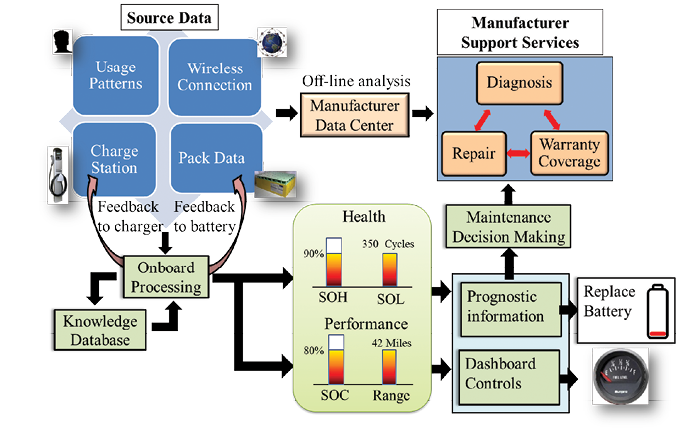
By Center for Advanced Life Cycle Engineering, University of Maryland
Lithium-ion batteries are the best commercially available power source for unmanned aircraft. But their reliability is impacted by temperature, acceleration and maneuvering during flight and degradation over time. They can also become unsafe if overheated. A smart battery management system can recognize and track these factors, giving operators the information they need for safer flights.
The constant struggle to trim aircraft weight has been a driving factor behind the widespread choice of lithium-ion batteries for unmanned systems. Of all currently available chemistries lithium-ion batteries offer the highest power and energy density allowing them to satisfy demanding power requirements while occupying less weight and volume than a nickel cadmium or lead acid cells. But the reliability of lithium-ion batteries—during missions as well as over their lifetimes—is impacted by several factors including discharge rate, temperature and amount of usage. A smart battery management system can recognize and track these factors, giving operators the information they need for safer flights.
There are already lithium-ion batteries being used in several commercial unmanned vehicles. They are providing power for the hybrid turbine-electric propulsion system in the Aurora Excalibur unmanned aerial vehicle (UAV), BAE System’s Talisman unmanned underwater vehicle, and Applied Geo Technologies’ small unmanned ground vehicle, among many others.
While the lithium-ion batteries may be the best commercially available option there are factors that can undercut their reliability. A lithium-ion battery pack, for example, is essentially a shrinking fuel tank, meaning that the maximum range of a battery-powered vehicle will shorten over time due to degradation. Additionally, the available battery capacity is dependent on the discharge rate, that is less energy can be extracted from a battery on a mission that requires high power for acceleration or advanced maneuvering than for less demanding missions. Temperature also affects the maximum deliverable capacity, with colder temperatures limiting the amount of energy that can be obtained from the battery. It is necessary to predict the battery’s ever-changing storage capacity so that a user can optimally plan a mission within the battery’s capabilities.
Finally, safety issues with lithium-ion batteries have been a hot topic, particularly in the case of electric vehicles. As unmanned vehicles find more applications outside of the military sphere, battery safety will undoubtedly become a focal point for regulators. Because lithium-ion batteries are used to store a large amount of energy within a confined space, the uncontrolled release of this energy poses a danger. If a lithium-ion battery experiences excessive heating, the cell casing could rupture and catch fire. These types of failures can spread throughout the entire battery pack and eventually to the host vehicle. Even if these failures can be detected minutes prior to a failure event, an operator would have time to maneuver the vehicle to an area where collateral damage is minimized.


Clairvoyant System
The uncertainty in the usability of an unmanned vehicle outfitted with a lithium-ion battery pack requires a smart battery management system (BMS) that is “clairvoyant” in the sense that it can recognize battery degradation and compensate for it. This is especially important for UAVs in which battery failure could result in loss of control of the aircraft leading to property damage or casualties.
The safety and control requirements of a battery necessitate the use of a BMS to ensure that the battery operates within acceptable limits. The battery management system comprises hardware and software that measures the properties of the battery and its ambient environment. It then gives the operator information on the remaining range before the vehicle’s battery needs to be recharged and when it should be replaced.
The techniques and methods involved in this process are all part of a broader discipline known as prognostics and health management (PHM), which uses a suite of sensing devices and in-situ processing techniques to determine the health of a system and provide a prediction of time to failure in real time.
A PHM-enabled battery monitoring package could also provide the user with fault detection of impending safety hazards and guidance for fleet management. For example, military operations require batteries be individually checked at specific time intervals to determine if replacement is necessary—a time consuming and tedious task for a large fleet of vehicles. Battery information transmitted wirelessly to a central database could be used to identify vehicles that require maintenance without the need to check each battery. Being able to predict and warn of catastrophic battery failures could be particularly valuable. If a battery fire were to break out in a warehouse storing multiple vehicles it might spread to the rest of the fleet and cause major losses.
Relying on Sensors
A BMS should provide a data link between the sensors in the battery pack and the wireless transmitter relaying information to the ground station. The sensor data collected would include the voltage of each individual cell, the current at certain nodes in the battery pack, and multiple thermocouple readings. New methods developed at the Center for Advanced Life Cycle Engineering (CALCE) are looking at how additional sensors (for measuring structural changes and moisture levels) can be used to improve battery monitoring and control.
It is a challenging problem to use such sensor information to determine the total amount of charge that a battery can deliver at any given time. Unlike a traditional gas tank in which the fuel level can be directly measured, the remaining charge in a battery is dependent on the number of lithium ions that can be shuttled between electrodes. This is usually reported as the battery’s state of charge (SOC), which is a measurement of the remaining charge stored in the battery. SOC cannot be measured directly, but it can be inferred from current, voltage, and temperature measurements. Unfortunately, sensor noise, degradation of the battery, and loading conditions can make this SOC inference difficult.
Commonly used methods for SOC estimation include coulomb counting and a voltage look-up table. Coulomb counting is an open-loop current integration method and may drift from true SOC due to measurement error. For voltage-based methods, while the battery voltage is closely tied to the SOC, it is a non-linear relationship influenced by temperature, the discharge current, and the age of the battery. It is possible to more accurately estimate the available charge by using onboard sensors to take measurements in real time and inputting them into a battery model to predict the SOC.
The Right Model
There are three major approaches to battery modeling. The first is based on electrochemical partial differential equations, which accurately match experimental data but are complex and time consuming to solve. The second modeling approach considers a battery as an equivalent circuit that represents the electrical characteristics of the cell. This approach can be solved quickly and used in real-time environments, but it does not accurately capture the physics of the battery at high discharge conditions. The third approach is purely data-driven and relies on machine learning algorithms to develop relationships between sensor inputs and the battery’s SOC. This type of approach often requires significant data to train the model. In resource-constrained computing platforms, such as UAVs, the complexity and accuracy of the model should be well balanced.
CALCE has developed equivalent circuit models for batteries and combined them with machine learning techniques such as neural networks for SOC estimation. Kalman filters are used with these models to form a closed-loop estimation of SOC, which is able to handle the measurement noise and compensate for errors so that models are self-corrective based on the output of the onboard sensors in the battery pack. To improve the model prediction accuracy for high discharge conditions, CALCE is working on order reduction of the electrochemical models to make them implementable in resource constrained computing platforms.
To limit risk, the BMS should relay the battery’s state of health (SOH) to the operator. The SOH metric gives the overall health of the battery as a percentage of a new pristine battery. SOH can be measured in a variety of ways. Typically, it relates the maximum deliverable capacity at any given time to the maximum deliverable capacity of the battery at the beginning of service. It can also be a measure of the reduced power that the battery can deliver as a result of increased charge transfer resistance and decreased diffusivity within the battery.
Preventing Catastrophic Failure
One aspect that is not currently encompassed in the SOH definition is the safety of the battery. Gas generation occurs as a result of side reactions within the battery, eventually leading to swelling of the battery packaging. The rate of gas generation could indicate dangerous side reactions preceding a thermal runaway. There is currently no methodology to detect gas generation and evaluate it as a precursor to catastrophic failure in-situ. Incorporating these features into an overarching SOH metric that is embedded into the BMS firmware could assist in mitigating catastrophic failures in UAVs.
CALCE is developing algorithms that can be used to provide advanced warning of battery failures. This work includes investigating battery behavior prior to short circuit failures through novel sensing and control techniques in order to identify precursors to failure. Most BMSs can detect sudden voltage drops or temperature increases that go along with a catastrophic failure. However, such failures typically proceed rapidly by the time these signals have been recognized. The risk of catastrophic failure is directly related to the use profiles the battery undergoes along with external stresses. Models are being developed at CALCE that adaptively predict failure from information gathered over the life cycle of the battery. Degradation models have been developed by regressing historical SOH data. Predictions of a battery’s remaining useful life can be made by extrapolating the model to a defined failure threshold.
Despite their many advantages, lithium-ion batteries need to be properly managed to ensure safety and long-term reliability. Considering the unique stresses that unmanned vehicles experience, custom management strategies are necessary. This includes both sensors for monitoring the usage conditions, as well as software and algorithms to process sensor data to maximize battery life and safety.
CALCE is at the forefront of battery testing, failure analysis, and control algorithm development for a variety of battery applications. For questions related to our work, please contact Michael Pecht at pecht@calce.umd.edu.






